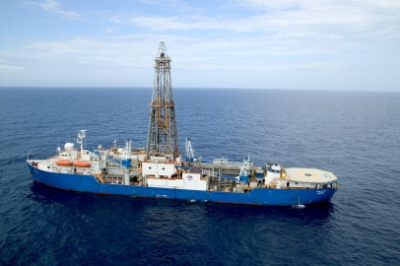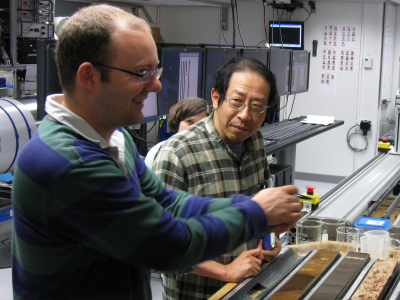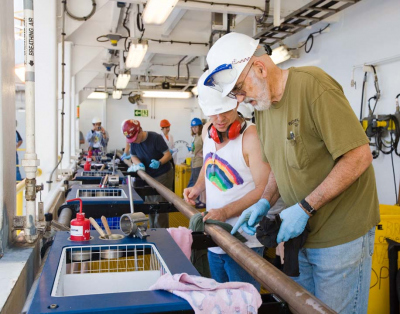Page path:
- Home
- Discover
- Media Releases
- Media Releases 2012
- 30-08-2012 Climate Change Stories from the Abys...
Climate Change Stories from the Abyss - New Nature Study Illuminates 55 Million Years of Climate History
The Pacific Ocean has remained the largest of all oceans on our blue planet for many million years. It covers one third of the Earth`s surface and has a mean depth of 4.2 km. Its biologically very productive equatorial regions play a very important role - particularly with regard to the global carbon cycle and long-term climate development. Therefore these tropical regions were the target area for an expedition of the US drilling vessel JOIDES Resolution in 2009 which was carried out in the framework of the Integrated Ocean Drilling Program (IODP). During four months an international team of more than 100 scientists and technicians recovered sediment cores from water depths between 4.3 and 5.1 km and drilled 6.3 km of sediment cores at eight locations. The cores offer an excellent archive of Earth’s history and span the past 55 million years.
„Nowadays we often discuss global warming induced by man-made carbon dioxide”, Prof. Heiko Pälike, co-chief scientist of the cruise and lead author of the Nature study, says. “However, on geological timescales of millions of years other processes determine the carbon cycle.” Volcanoes are one major source of carbon dioxide input to the atmosphere. On the other hand the greenhouse gas is removed by weathering of rocks made up of carbonate. “The overall balance of these processes is reflected in the deep ocean`s carbonate compensation depth, the CCD”, the MARUM scientists points out. This invisible surface is defined as the depth in the oceans at which the mineral calcite is dissolved. Below the CCD hardly any biological remains made from carbonate, for example chalk and microscopic plankton, are preserved: Instead the sediment consists mostly of clay and plankton remains made from silica.
The interesting point the Nature study focusses on is this: The carbonate boundary is fluctuating over time. It shallows during periods of warm climate and normally deepens when ice age conditions prevail.
In their Nature study Pälike and co-workers demonstrate that in the equatorial Pacific the carbonate compensation depth (CCD) was at 3.3-3.6 km 55 million years ago. Between 52 and 47 million years before present, when very climate warm conditions prevailed, the CCD leveled up to 3 km. 34 million years ago, when the Earth slowly but steadily cooled and first ice domes formed in Antarctica the CCD went downhill, too. 10.5 million years ago it reached 4.8 km.
The cores drilled during the expedition strikingly demonstrate that the interplay of climate development and carbon cycle was not a one-way street at all: “From 46 to 34 million years ago, when Earth turned into a permanent icehouse, our record reveals five intervals during which the CCD fluctuated upwards and downwards in the range of 200 and 900 meters”, geoscientist Heiko Pälike says. “These events, that often mirror warming and cooling phases, persisted between 250,000 and one million years.” Similar episodes were registered in the sediment cores for later parts of the Earth`s history. 18.5 million years ago the CCD moved upward about 600 meters – only to sink down to 4.7 km 2.5 million years later. Today the Pacific carbonate compensation depth is at 4.5 km.
More information / interviews / images:
„Nowadays we often discuss global warming induced by man-made carbon dioxide”, Prof. Heiko Pälike, co-chief scientist of the cruise and lead author of the Nature study, says. “However, on geological timescales of millions of years other processes determine the carbon cycle.” Volcanoes are one major source of carbon dioxide input to the atmosphere. On the other hand the greenhouse gas is removed by weathering of rocks made up of carbonate. “The overall balance of these processes is reflected in the deep ocean`s carbonate compensation depth, the CCD”, the MARUM scientists points out. This invisible surface is defined as the depth in the oceans at which the mineral calcite is dissolved. Below the CCD hardly any biological remains made from carbonate, for example chalk and microscopic plankton, are preserved: Instead the sediment consists mostly of clay and plankton remains made from silica.
The interesting point the Nature study focusses on is this: The carbonate boundary is fluctuating over time. It shallows during periods of warm climate and normally deepens when ice age conditions prevail.
In their Nature study Pälike and co-workers demonstrate that in the equatorial Pacific the carbonate compensation depth (CCD) was at 3.3-3.6 km 55 million years ago. Between 52 and 47 million years before present, when very climate warm conditions prevailed, the CCD leveled up to 3 km. 34 million years ago, when the Earth slowly but steadily cooled and first ice domes formed in Antarctica the CCD went downhill, too. 10.5 million years ago it reached 4.8 km.
The cores drilled during the expedition strikingly demonstrate that the interplay of climate development and carbon cycle was not a one-way street at all: “From 46 to 34 million years ago, when Earth turned into a permanent icehouse, our record reveals five intervals during which the CCD fluctuated upwards and downwards in the range of 200 and 900 meters”, geoscientist Heiko Pälike says. “These events, that often mirror warming and cooling phases, persisted between 250,000 and one million years.” Similar episodes were registered in the sediment cores for later parts of the Earth`s history. 18.5 million years ago the CCD moved upward about 600 meters – only to sink down to 4.7 km 2.5 million years later. Today the Pacific carbonate compensation depth is at 4.5 km.
More information / interviews / images:





